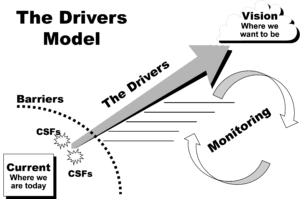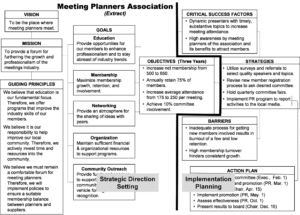As you take on strategy development, a critical step is to ensure that you and your team have a common understanding of the language of strategy and a solid process to carry you through strategy development. It is important to put the language and process in place early to avoid the confusion, debates, and wasted time that come from lacking an agreed-upon approach and set of definitions.
The Drivers Model is the tool I have been using for over two decades to provide a robust, yet simple, method for taking an organization through strategic planning, project planning, program planning, and numerous other planning activities. The Drivers Model is fully scalable and applies to Fortune 500 companies, non-profit organizations, government agencies, entire enterprises, single business units, field offices, individual departments, and any work team.

The Drivers Model Structure
From time to time, I’m asked to explain how the Drivers Model differs from other planning models. I divide this question into two parts: First, what is different about the way the Drivers Model is structured? And second, what is different about the way the Drivers Model is executed? Let’s look first at the structure.

| Elegantly simple | Many executives see planning, and specifically strategic planning, as a highly challenging and complex activity. The Drivers Model provides an approach that is elegantly simple, yet robust and comprehensive enough to serve both a multi-billion-dollar corporation and a half-million-dollar non-profit. |
| Strategy document | In a single, 11×17 page folded in half, you have all the core elements of your strategic plan. For management teams and employees, the strategy document serves as an easily accessible and understandable roadmap of the strategic direction. |
| Clear definitions | No more arguing about what is a goal and what is an objective! No more debates about what should be included in a vision vs. a mission statement. The Drivers Model provides clear, concise, and easy-to-adopt definitions for each element of your plan. |
| SWOT format | The Drivers Model provides a more complete analysis of strengths, weaknesses, opportunities, and threats by identifying both the attribute and impact of each element. This deeper analysis helps ensure a common understanding of the current conditions facing the organization. |
| Mission–vision distinction | The clear distinction between mission (what you do, for whom, and the benefit) and vision (the preferred picture of the future) helps you to be both definitive and aspirational at the same time. |
| Goals–objectives relationship | The relationship defined between goals (broad aims that define fulfillment of the mission) and objectives (specific, measurable targets that define accomplishment of the goal) ensures that your objectives focus on measuring results rather than measuring activities. |
| CSFs and barriers | How do you make sure your strategies are the most important activities for your organization’s focus? The Drivers Model answers the call by having you identify the critical conditions for success and the major barriers standing in your way. So, each of your strategies should create a critical condition, overcome a barrier, or both. |
| Monitoring processes | Many plans fail in execution, due to a lack of focus and commitment. The three-level monitoring model encourages both the focus and commitment needed to deliver on the plan’s promise. |
Executing the Drivers Model
While the model’s structure is different from the typical way strategic plans are created, the other difference is in how the Drivers Model executed. The facilitation processes are designed to deepen understanding of the current situation, focus the conversation on the most essential elements of the strategy, and build buy-in and commitment to execution every step along the way. My book, The Executive Guide to Facilitating Strategy, contains over twenty-five facilitation strategies related to executing the Drivers Model, including strategies for building a mission statement in under 90-minutes, set specific, realistic, achievable, and relevant targets, and developing and implementing guiding principles so that move from being a plaque on the wall to serving as guide posts that your people use every day. I’ve summarized several key execution strategies below.
| The management briefing | You can gain buy-in to the planning activity by holding one or more management briefings. Use the management briefing to have the planning team identify the most critical issues facing the organization. Then, show how the planning process will help the team address those issues. |
| Briefing book review | Early on in many planning processes, teams spend considerable time compiling a briefing book that assesses the current situation. But how do you ensure that key information from the briefing book is carried through the planning process? With the Drivers Model, planning team members identify key observations from the briefing book review, and document potential strategies for addressing them. The potential strategies serve as the bridge between the past and the future, and are considered during strategy development that occurs later in the Drivers Model process. |
| The power of verbs | The Drivers Model defines specific differences among the verbs used for each planning component.
· Goals start with infinite verbs (e.g., maximize, provide, maintain). · Objectives begin with quantity verbs (e.g., increase, decrease, reduce). · Strategies use finite verbs (e.g., establish, develop, implement). These distinctions provide a level of consistency that helps produce a quality plan. |
| Informed majority process | Teams often waste time debating the exact words to use to describe, for example, a goal or a positioning statement. The Drivers Model includes a structured process called “informed majority” to minimize time wasted in wordsmithing. |
| Establishing the mission | The structured process to help organizations define their mission often results in a mission statement developed in under an hour. The three key questions, “What do we do? For whom? What is the benefit?” bring focus and clarity to mission development. |
| Identifying goals | The Drivers Model includes a powerful visualization process that helps teams visualize future success. From the visualization, teams are able to quickly identify their goals and build robust goal statements. |
| Defining objectives | The Drivers Model eases this notoriously difficult process through a simple, five-step process that results in specific, measurable targets for each goal. |
| Developing strategies | While brainstorming potential strategies is an important part of any planning process, the Drivers Model follows the brainstorming with a rigorous review of CSFs and barriers to ensure that the plan addresses major impediments and creates the critical conditions for success. |
| Setting priorities | Developing strategies is important, but few organizations can simultaneously undertake all the activities of a typical plan at once. It is essential to set priorities. The Drivers Model priority-setting process includes a period of controlled lobbying to build strong consensus and commitment. The lobbying process gives each person the floor for a brief period to lobby the entire group in support of one or more strategies. The lobby process helps build consensus around particular solutions, as participants repeatedly hear support for a small number of strategies. In addition, once the prioritization is complete and it is time to assign responsibilities, people volunteer more readily to lead items for which they lobbied. |
| Success strategies and quality checks | Each component of the Drivers Model includes a list of success strategies that outline best practices for developing that component. The Drivers Model also includes component-specific sets of quality checks to confirm that your team has done a good job. |
I believe these structure and execution differences help make the Drivers Model a superb approach to planning for organizations of all sizes and types.
To learn more about facilitation skills, consider our course, The Effective Facilitator. The four-day course provides a structured approach for leading teams and facilitating meetings and covers over 100 techniques for getting amazing results from groups.
About the Author
Michael Wilkinson is the trailblazing Founder of Leadership Strategies, renowned as the foremost provider of professional facilitators and facilitation training in the US. As a Certified Master Facilitator and a Certified Professional Facilitator, Michael’s expertise is in high demand as a trainer, facilitator, and keynote speaker. With a track record of leadership in the facilitation industry, including roles as past president of the Southeast Association of Facilitators, creator of the FindaFacilitator.com database, and founding board member of the International Institute of Facilitation, Michael is a leader in the industry. Dive deeper into his wealth of knowledge through his acclaimed books, including The Executive Guide to Facilitating Strategy, The Secrets of Facilitation, The Secrets to Masterful Meetings, and CLICK: The Virtual Meetings Book.

